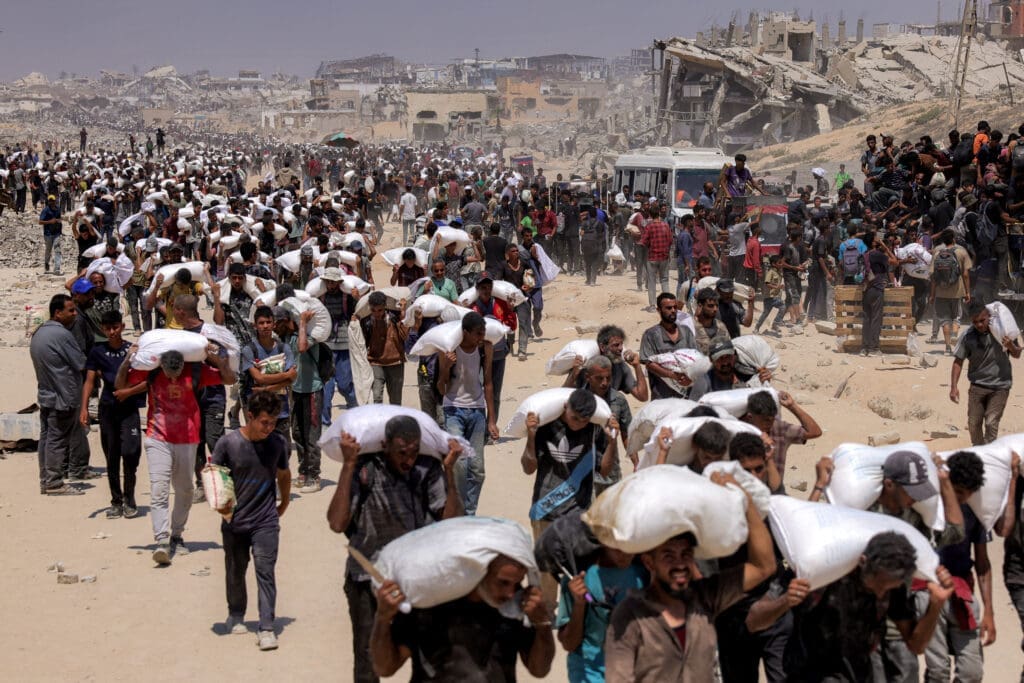It has been four months since Israel unilaterally terminated a ceasefire with Hamas and imposed a crippling siege on Gaza, preventing the entry of nearly all food, clean water, medicine and other essential supplies. The results have been catastrophic.
On July 19 alone, 18 people were recorded as having died of starvation, while the World Food Program estimates that a third of Gaza’s population goes several days without eating. Hospitals in the territory are reporting an overflow of Palestinians arriving after collapsing in the street from severe malnutrition. Desperate masses seeking food are being gunned down, bombed and shelled at aid distribution sites run by Israeli-sponsored private contractors, in what the United Nations Relief and Works Agency (UNRWA) characterized as “sadistic death traps.”
Israel is waging a war of starvation under the repeatedly debunked pretext of denying aid to Hamas—which, if true, would also mean it is willfully starving its own soldiers held captive by the group. It is clear, however, that Israel’s deprivation policy has little to do with Hamas and more to do with advancing its genocidal aims in Gaza through a four-part strategy that includes preventing the entrance of readily available supplies, facilitating organized crime, fomenting lawlessness and chaos, and using aid distribution to corral and control the population and cover up starvation.
Arbitrarily Blocking Aid
The first pillar in Israel’s strategy of engineering famine in Gaza relies simply on blocking as much aid from entering the territory as possible.
On July 18, UNRWA—one of many organizations supplying aid—announced it had enough food on its own for every person in Gaza for more than three months, but those supplies were stockpiled just across the border in Egypt awaiting Israel’s permission to enter the strip.
Currently, only an average of 28 supply trucks enter Gaza each day. By comparison, during the January-March ceasefire, Israel allowed 600 trucks to enter the territory daily, demonstrating the capacity to process far more than is currently allowed. The decision not to do so is a deliberate effort to weaponize the smaller amount of aid available.
Israel’s military is using a number of mechanisms for restricting the entry of goods, including imposing arbitrary, unannounced and ever-changing guidelines for what can pass through, then thoroughly inspecting each truck and turning back entire convoys if a single prohibited item is found inside. Such contraband has included tents of the wrong color, nail clippers, crutches, hygiene kits, seeded fruits, medical equipment and even baby formula.
Another mechanism is to demand that trucks unload their cargo at Israeli crossings and force Gaza’s dwindling “fleet” of trucks, which must first apply for difficult-to-get permits, to drive through dangerous and destroyed routes to collect the cargo. Indeed, bureaucratic procrastination is a cornerstone of this strategy—through long delays in granting trucks safe passage, processing cargo slowly, barring trucks from transferring aid to warehouses and distribution sites, and arbitrary closures of the crossings in their entirety.
Additionally, Israeli troops routinely fire on aid convoys, which has a chilling effect on drivers. At least 305 UN workers have been killed by Israel in 20 months, the highest number ever recorded in the UN’s history. Lastly, the government and military often tip off violent Israeli extremists and stand by while they block or sabotage aid convoys.
Empowering Gangs, Facilitating Theft
The few aid trucks that make it into Gaza, after all the Israeli impediments, are then met with another sinister tactic to ensure their cargo does not reach the people in need. In the second pillar of Israel’s strategy, its forces channel truck drivers through what has come to be known as “looting valley,” where criminal gangs intercept the convoys and steal their supplies. Indeed, these gangs—which have been armed, financed and protected by Israel—are responsible for the overwhelming majority of looting in Gaza. In one incident last May, an Emirati convoy was stopped by organized criminals who looted 23 out of 24 trucks. In a single day in November, the gangs looted 97 trucks out of a convoy of 109—all under Israeli military oversight.
This manufactured looting crisis not only further limits aid delivery, but allows Israel to then assign blame to Palestinians themselves, especially Hamas. Yet in May, the military acknowledged internally that out of 110 looting incidents it documented, none were carried out by Hamas. A month later, Israel admitted that it has been directly supporting those very same ISIS-linked criminal networks, particularly the notorious Abu Shabab gang.
Furthermore, the criminals would often beat, kill, maim or hold truck drivers hostage to scare others away from even attempting to reach Israeli crossings to collect aid—which only works to the benefit of the starvation campaign and not the criminals. Israel then blames UN agencies for failing to collect the food accumulating at the crossings. In May, the military claimed it cleared 760 aid truckloads within 12 days, but only 238 were collected by Gazan trucks, half of which were looted. This means nine trucks per day reached the population—less than two percent of the minimum 500-600 trucks needed for basic survival.
Engineered Lawlessness and Societal Collapse
Trucks that survive the gauntlet of Israeli restrictions and the looting valley are then often swarmed by tens of thousands of starved Palestinians desperate to get their hands on a modicum of food.
Yet this is not a coincidence, either. The third pillar of Israel’s approach involves deliberately engineering lawlessness and disorder in Gaza. It has systematically targeted law enforcement authorities, civil defense personnel, government civil servants and emergency committees, which has led to the collapse of civic order and the spread of criminal activity. Israeli-backed gangs have not only stolen aid but have also targeted hospitals, businesses, markets and other places to sow chaos. Even if a person is lucky enough to obtain a bag of flour, they are often stopped on the street by gang members and robbed.
Whenever someone tries to fill this organizational vacuum, they are targeted by Israel, which has repeatedly bombed volunteers attempting to secure aid trucks, prevent looting and ensure orderly distribution. During a notable instance in June, some Gazan clans unaffiliated with Hamas stepped up to protect aid convoys; Israel immediately responded by halting the entry of aid into Gaza and targeting multiple volunteers.
Humanitarian Cover
The fourth, and perhaps most dystopian, pillar has been Israel’s establishment of the Gaza Humanitarian Foundation (GHF), a start-up entity of private contractors and mercenaries that has deliberately displaced all other aid organizations operating in Gaza. Since the GHF launched operations on May 26, its sites have become notorious for daily massacres of aid seekers. The organization has also been widely criticized for its inadequate provision of food, at best distributing the contents of 20 trucks per day and opening arbitrarily for a few minutes each day.
The unstated purpose of the GHF is to take distribution out of the hands of professionals who are actually able to meet the basic needs of the people and put it in the hands of those answering to the Israeli military. This allows Israel to weaponize aid distribution and starvation to achieve its aim: to corral the surviving population into ever-shrinking zones under Israeli control. That is why the GHF reduced the active distribution centers from 400 to just four, making it nearly impossible for most people in Gaza to reach those sites without relocating.
In the daily chaos that ensues as hundreds of thousands of Palestinians clamor to reach the food at these sites, GHF security personnel and the Israeli military use live fire, grenades and tank shells—adding a layer of misery and suffering to the lives of innocent civilians who must choose between risking death from starvation or from bullets. Again, the aim is to make life so unbearable that people will “voluntarily” leave Gaza at the earliest opportunity or perish before they have the chance.
The GHF also serves to create the appearance that aid is still being distributed in Gaza—without actually delivering it to the population in any meaningful or sustained way. It is a scheme designed to give Israel enough cover to prevent “a total collapse of international legitimacy for continuing the war.” It also removes credible international observers from respected aid organizations witnessing Israel’s genocide from the ground.
Applying Pressure
Israel is using its policy of forced starvation for multiple ends. In addition to contributing to the collapse of Palestinian society in Gaza, it is a means of pressuring Hamas. Much like Israel targets civilians and civilian infrastructure in its bombing campaigns to pressure enemy groups like Hamas and Hezbollah—in what is known as the Dahiyeh doctrine—so too does it withhold food aid from civilians to apply pressure. In June, a senior Arab official with knowledge of the talks said privately that Israel has been using this illegal and immoral policy “as leverage in negotiations” with Hamas, offering to trade the entry of aid in exchange for the release of hostages.
Hence, it is no coincidence that all of the barriers to aid manufactured under Israel’s four-pronged strategy disappeared during the January ceasefire, when Hamas agreed to release Israeli captives in exchange for the entry of aid. The gangs vanished into thin air, the looting stopped, and food reached people directly and in an orderly fashion. Yet even if Hamas were to release all remaining captives, Israeli officials have vowed to resume their war of annihilation, including through starvation.
Based on these four pillars, Israel has constructed an architecture of famine sustained by blockade, proxy violence, institutional collapse and deadly deceit disguised as relief. Each pillar is not incidental, but essential to a system designed to brutalize and humiliate a besieged population into submission, fleeing or death.
The opinions expressed in this article are those of the author and do not necessarily reflect the views of the Middle East Council on Global Affairs.


